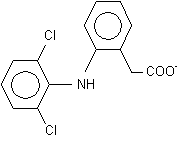Diclofenac
Diclofenac (marketed as Voltaren®, Voltarol®, Diclon® and Cataflam®) is a non-steroidal anti-inflammatory drug (NSAID) taken to reduce inflammation, such as in arthritis or acute injury. It can also be used to reduce menstrual pain. more...
Voltaren and Voltarol contain the sodium salt of diclofenac. In the United Kingdom Voltarol can be supplied with either the sodium salt or potassium salt, while Cataflam in some other countries is the potassium salt only. Diclofenac is available in stomach acid resistant formulations (25 and 50 mg), fast disintegrating oral formulations (50 mg), slow- and controlled-release forms (75, 100 or 150 mg), suppositories (50 and 100 mg), and injectable forms (50 and 75 mg). Diclofenac is also available over the counter (OTC) in some countries: Voltaren® dolo (12.5 mg diclofenac as potassium salt) in Switzerland and Germany, and preparations with 25 mg diclofenac are OTC in New Zealand. OTC use is approved for minor aches and pains and fever associated with common infections.
Diclofenac is available as a generic drug in a number of formulations.
Mechanism of action
The exact mechanism of action is not entirely known, but it is thought that the primary mechanism responsible for its anti-inflammatory/antipyretic/analgesic action is inhibition of prostaglandin synthesis by inhibition of cyclooxygenase (COX).
Diclofenac, it seems, may also be a unique member of the NSAIDs. There is some evidence that diclofenac inhibits the lipooxygenase pathways, thus reducing formation of the leukotrienes (also pro-inflammatory autacoids). There is also speculation that diclofenac may inhibit phospholipase A2 as part of its mechanism of action. These additional actions may explain the high potency of diclofenac - it is the most potent NSAID on a molar basis.
Inhibition of COX also decreases prostaglandins in the epithelium of the stomach, making it more sensitive to corrosion by gastric acid. This is also the main side effect of diclofenac. Diclofenac has a low to moderate preference to block the COX2-isoenzyme (approximately 10-fold) and is said to have therefore a somewhat lower incidence of gastrointestinal complaints than noted with indomethacin and aspirin.
The action of one single dose is much longer (6 to 8 hours) than the very short half-life of the drug indicates. This could partly be due to a particular high concentration achieved in synovial fluids.
Common uses
Diclofenac is used for musculoskeletal complaints, especially arthritis (rheumatoid arthritis, osteoarthritis, spondylarthritis, ankylosing spondylitis), gout attacks, and pain management in case of kidney stones and gallstones. An additional indication is the treatment of acute migraines. Diclofenac is used commonly to treat mild to moderate post-operative or post-traumatic pain, particular when inflammation is also present, and is effective against menstrual pain.
Read more at Wikipedia.org



